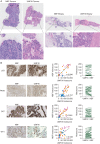Methanol-based fixation is superior to buffered formalin for next-generation sequencing of DNA from clinical cancer samples
- PMID: 26681675
- PMCID: PMC4769995
- DOI: 10.1093/annonc/mdv613
Methanol-based fixation is superior to buffered formalin for next-generation sequencing of DNA from clinical cancer samples
Abstract
Background: Next-generation sequencing (NGS) of tumour samples is a critical component of personalised cancer treatment, but it requires high-quality DNA samples. Routine neutral-buffered formalin (NBF) fixation has detrimental effects on nucleic acids, causing low yields, as well as fragmentation and DNA base changes, leading to significant artefacts.
Patients and methods: We have carried out a detailed comparison of DNA quality from matched samples isolated from high-grade serous ovarian cancers from 16 patients fixed in methanol and NBF. These experiments use tumour fragments and mock biopsies to simulate routine practice, ensuring that results are applicable to standard clinical biopsies.
Results: Using matched snap-frozen tissue as gold standard comparator, we show that methanol-based fixation has significant benefits over NBF, with greater DNA yield, longer fragment size and more accurate copy-number calling using shallow whole-genome sequencing (WGS). These data also provide a new approach to understand and quantify artefactual effects of fixation using non-negative matrix factorisation to analyse mutational spectra from targeted and WGS data.
Conclusion: We strongly recommend the adoption of methanol fixation for sample collection strategies in new clinical trials. This approach is immediately available, is logistically simple and can offer cheaper and more reliable mutation calling than traditional NBF fixation.
Keywords: HGSOC; NBF; SNVs; UMFIX; copy-number abnormalities; fixation; next-generation sequencing.
© The Author 2015. Published by Oxford University Press on behalf of the European Society for Medical Oncology.
Figures




References
-
- Turashvili G, Yang W, McKinney S et al. . Nucleic acid quantity and quality from paraffin blocks: defining optimal fixation, processing and DNA/RNA extraction techniques. Exp Mol Pathol 2012; 92: 33–43. - PubMed
-
- Vincek V, Nassiri M, Nadji M, Morales AR. A tissue fixative that protects macromolecules (DNA, RNA, and protein) and histomorphology in clinical samples. Lab Invest 2003; 83: 1427–1435. - PubMed
Publication types
MeSH terms
Substances
Grants and funding
LinkOut - more resources
Full Text Sources
Other Literature Sources
Molecular Biology Databases

